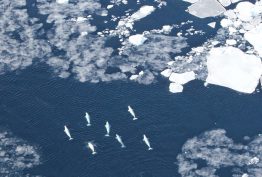In recent decades, parts of the Arctic seas have become increasingly ice-free in late summer and early fall. As sea ice is expected to continue to recede due to climate change, seasonal ship traffic from tourism and freight is projected to rise. A study from the University of Washington and the University of Alaska Fairbanks is the first to consider potential impacts on the marine mammals that use this region in autumn and identify which species will be most vulnerable.
Read more at UW Today »Department of Earth and Space Sciences welcomes new Chair, Ken Creager
The University of Washington’s College of the Environment is pleased to announce that Professor Ken Creager will serve as Chair of the Department of Earth and Space Sciences for a two-year term that began on July 1, 2018. During the search process, Creager — who has served in a number of leadership roles within Earth and Space Sciences and is regarded as a trusted, respected leader within the Department and College — emerged as the Advisory Search Committee’s top choice to lead the Department in the coming years.
Read more »Polar scientist Kristin Laidre documents perspectives of polar bear hunters in East Greenland
Few people have spent as much time studying mammals in the Arctic as Kristin Laidre, a University of Washington polar scientist and expert on marine mammals. One exception would be Inuit subsistence hunters, who for generations have relied on these mammals for nutritional, economic and cultural reasons. A new study documents the experience of these hunters and what it might show about changing conditions for polar bears on Greenland’s east coast.
Read more at UW Today »Broccoli in space: How probiotics could help grow veggies in microgravity
Astronauts at the International Space Station are spending more time away from Earth, but they still need their daily serving of vegetables. In the quest to find a viable way for crew to grow their own veggies while orbiting, student researchers are sending broccoli seeds coated with a healthy dose of probiotics to space. Six broccoli seeds are aboard the Orbital ATK Cygnus spacecraft that launched last week from Wallops Island, Virginia, as part of a space station cargo resupply mission.
Read more at UW Today »A promising target in the quest for a 1-million-year-old Antarctic ice core
Ice cores offer a window into the history of Earth’s climate. Layers of ice reveal past temperatures, and gases trapped in bubbles reveal past atmospheric composition. The oldest continuous ice core so far comes from Dome C in East Antarctica and extends back 800,000 years. But a tantalizing clue recently offered the possibility to go back even further. A collaborative study between the University of Washington and the University of Maine now pinpoints a location where an entire million years of undisturbed ice might be preserved intact.
Read more at UW Today »





